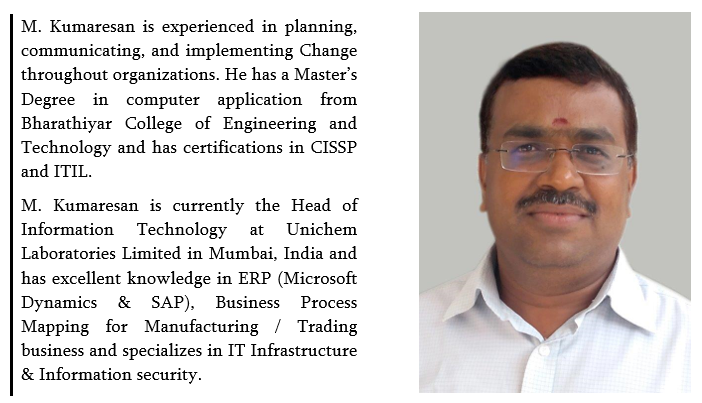At Q7 Consulting, we are aware that we live in times of uncertainty and now more than ever Change Management and Leadership within organizations are essential concepts for success.
The people we interview are from all around the world, have outstanding professional trajectories and attained success within their roles. They have essential leadership traits, are influential within their organizations and have experience implementing and managing Change.
In this seventh episode of our new series, we interview M. Kumaresan, Head of Information Technology at Unichem Laboratories Limited who provides deep insight on planning and executing Change.

Please find below the main questions addressed in our interview with M. Kumaresan with some examples embedded in the answers.
What have been your takeaways from managing Change?
This pandemic has changed the way people work. Before the pandemic, we never offered the option to work from home and this pandemic has Changed the way people work from home and still achieve results. Change is essential for any organization that wants to grow. This pandemic has also taught everyone that Change is required for companies to survive.
What is your advice to people who start managing major Changes in organizations for the first time?
Organizations cannot have a major Change in an easy way. My advice is to take a major Change and break it into smaller bits and pieces. Never try to tackle the mountain head on. Just take small steps, show the positive ways and results. This way you can gradually move your major Change into the organization.
Major Change at one go will not fly because people are used to work in a certain way, and if you suddenly push major Change people will not accept it. Make the major Change your goal and gradually split into different levels and try to achieve the different milestones to achieve the major Change.
What was your role in making Changes in the organization and were the Changes clearly linked to the mission and vision of the company?
My role was to ensure I have buy-in with my leadership team to make Change management projects the top priority. Basically, people need to take the Change in a positive way whenever you are approaching any Changes in the organization and have the mission and vision of the company very clearly defined in the different levels of the company. There should be one captain for the Change, who compiles ideas in a casual way and immediately gets a reaction.
For example, our company is a product company and IT is considered as one of the pillars of our business enablers, so the Change owner and impacted people should be on the same boat and convey the message along with the organization’s mission and vision not only in the formal way, but also it should be about the Walk the Talk way.
How did your company support you in getting ready to lead / manage Change?
I really got 100% support from my company. I will give you a simple example: last year my reporting manager asked me to get away from my normal IT work, get into the business and try to see where we can really make a Change. Sit with the plant head, discuss with him to find their key pain areas and try to implement suggestions based on my commercial knowledge and business sense.
Top management trusted in me and hence gave full support to lead the changed in the process automation.
What strategies worked and did not work to communicate the Changes and what strategy did you use to generate a sense of urgency with people?
During the lunch or coffee break, start discussing about the company and what you are trying to do with the Change, not in a formal way just in a casual way. When you go to people’s desks and start talking in a formal way, they say “What? Why is this guy doing Changes when we have a good profit? Why do we want to Change?” So, compile your ideas in a casual way and you immediately get a reaction from people. If the reaction is positive, then you can put more on their plate. When people are really interested, they will definitely listen and if they are not interested then it’s not the right time.
You also need to understand the culture. For example, in some cultures you can talk very directly. In other cultures, it should be semi-formal, one day you send a formal communication and then follow up with a semi-formal approach. Just go and talk to people for a couple of minutes, mixing up their area with the Change.
How did you approach planning Changes? How well were the Change plans followed and how did you approach Changes to the plans?
You have to sit with the different teams and try to find their pain area. Start off with the department head and then with the team as a whole. You have to ask the top management if they are happy with the current situation as a way to gain support. If top management is happy with the current situation, then your Change may not be adopted.
Another approach is to hire top multicultural talent with an open mind to execute such Changes. As a first step you need to understand the organization in order to plan the Change, have monthly meetings about the progress on the Change, the challenges and actions to be performed to surpass these challenges (Review Mechanism).
What strategies did you use to attain milestones and make achievements visible?
When the organization makes a product, make sure that your production yields are in accordance to your production capacities. This is very important in the pharmaceutical industry because you have to manage the capacity planning in the production of pills (for example) based on the available production capacity. Attention to the detail will undoubtedly aid you to attain the milestones and the achievements will be visible on their own.
What did you do to keep people committed? What did you do to keep people from going back to old ways?
After the Change has gone live (implementation), then you have to monitor for one year. Check-up once per month to verify if the Change has taken hold or if people are going back to old ways. This monitoring is a way to push people to continue adopting the new ways. If you implement and then assume that everyone will continue with the Change, then there is a possibility that people will go back to old ways.
Did you underestimate or overestimate what was needed to be done to achieve Change?
Sometimes we do, but that’s the human tendency to underestimate or overestimate. You need to understand as much as possible the system in which you are performing so you can deliver a right estimation.
What worked and what did not work in planning and executing Changes?
It will not work if you depend on one person too much, because planning will Change multiple times. Reduce dependency on a single person by getting as many people involved and updated on what is going on and what needs to be done.
Work continuously to communicate with the team and monitor progress. Motivation is also key for planning and executing Changes. An effective way to motivate people is to eliminate the hierarchy, that is, to allow people from different levels of the organization to reach you and talk to you directly.
